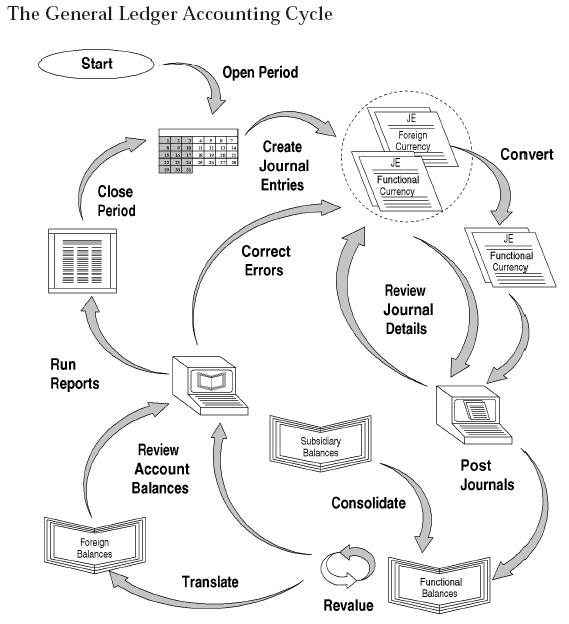
Oracle General Ledger
Encyclopedia
The Oracle General Ledger module within Oracle Financials is an integrated part of the ERP package of Oracle applications. It is a financial management solution within E-business suite for entering and reporting on the financial data of large companies. Oracle claims its GL module can import and post 42 million journal lines per hour, which would make it a suitable GL application for very large enterprises with high GL transaction volume.

Before setting up oracle GL, The following need to be set up:
(M) = Mandatory step, others are optional
Once the above steps are done, to implement Oracle GL the following need to be set up
Other features of Oracle GL include
Scope
The screenshot below from Oracle demonstrates the accounting cycle of Oracle General Ledger.
Before setting up oracle GL, The following need to be set up:
(M) = Mandatory step, others are optional
- Chart of Accounts (M)
- Account Combinations
- Period Types (M)
- Calendar (M)
- Transaction Calendar
- Currencies (M)
- Set of Books or SOB (M)
- Assign SOB to a responsibility (M)
- Daily conversion Rate types (M)
- Rates
Once the above steps are done, to implement Oracle GL the following need to be set up
- Journal Sources (M)
- Journal categories (M)
- Suspense Accounts
- Inter-company and Summary Accounts
- Statistical UOM (Unit of Measure)
- Historical Rates and Document Sequences
- Automatic Posting and Incumberance types
- System Controls (M)
- Budgetory Control Groups
- Profile options (M)
- Open / Close GL accounting periods.
Other features of Oracle GL include
- A single legal entity is possible to assign with multiple ledgers to meet statutory, corporate and regulatory reporting.
- Multi-currency functionality
- Chart of Accounts is created segment-wise for reporting hierarchies. Up to 30 segments can be created in a chart of accounts with 25 characters per segment.
- Financial Statement Generator (FSG) which comes with Oracle GL generates financial reports, such as the income statements and balance sheets from the GL data applying the access security rules. Ad-hoc reports can be prepared with the FSG.
- Technically, oracle General Ledger - Release 11i contains approximately 130 tables, excluding the temporary processing tables, 70 forms and 140 concurrent programs or reports. The tables and forms which are part of and accessible to GL , but are not owned by the GL user are not included in the above counts. e.g. FND objects owned by APPLSYS are not included.
Further reading
- Cameron, Melanie. Oracle General Ledger Guide (2009) McGraw-Hill. ISBN 0071622292.

